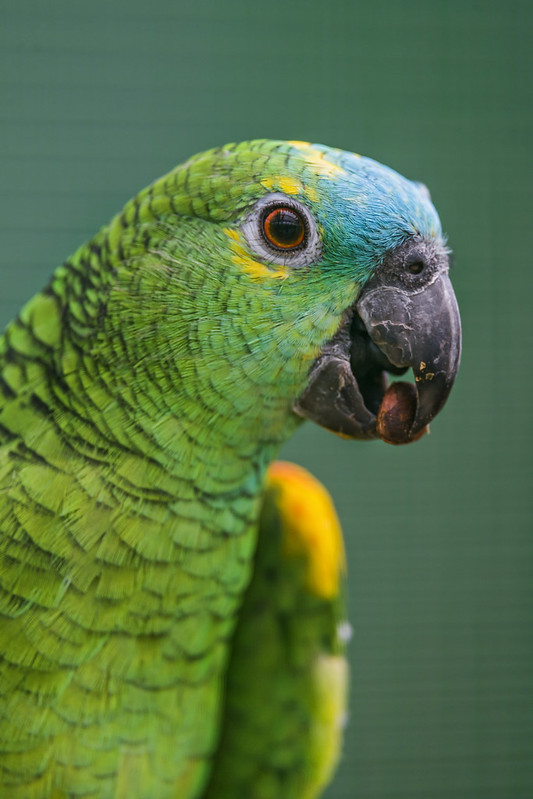 |
Blue-Fronted Amazon Parrot - Photo by Tambako the Jaguar  |
There are several species of Amazon Parrots. Some of the most common species are the double yellow headed amazons, yellow napped amazons, yellow or blue fronted amazons, orange winged amazons, green cheeked amazons, and lilac crowned amazons.
A healthy Amazon can be expected to have a lifespan of around 50 years or even longer with good nutrition and care and their size can range anywhere from about 10-20 inches in length.
The affectionate and loyal nature of the Amazon makes this bird a wonderful pet for those experienced with companion parrots. Amazons are highly intelligent and require a devoted owner who is willing to provide significant and meaningful attention, as well as stimulus such as chewing toys to keep them happy and healthy.
Some males can become aggressive when they reach sexual maturity. Gentle dominance training is essential. It is a good idea to teach amazons to step up on a stick on command for those times when they are "over-stimulated." These birds require strong, patient owners who understand their moods. Do plenty of research on behaviour and training before buying one so you can build a strong foundation with the young bird.
The best talkers tend to be the double yellow heads, yellow napes, and blue fronts. Many of these birds can also become proficient singers. They are not shy and will often perform for strangers. Because of these characteristics, these parrots are often selected as performers in bird shows and at zoos.
Generally, they do not develop feather picking problems the way many parrot species do, but they can if they are neglected, confined in small cages for long periods of time, and not stimulated with interaction and/or toys.
Caging
Amazons are quite active and very prone to obesity if they do not get exercise. The cage provided should be large enough to ensure that they get an adequate room for play and exercise. A spacing of bars depends on the size of the species and care should be taken for smaller amazons to ensure that the spacing is not large enough for them to get their head through.
Diet
A diet that is about 25-50 per cent pellet based, with the rest made up of a variety of healthy fresh foods is generally accepted as a good guide. Seeds are too high in fat for Amazons and while they can be fed as treats, they should make up no more than 10 per cent of the whole diet. Nuts are a good treat, also in moderation.
Feather and Skin Health
Amazons should be showered regularly for feather and skin health. They can develop a musky odour that bothers some people, but most owners will need to get used to it. Regular showers keep the smell from getting too strong.
Noise
Most birds purchased young and properly trained and socialized will rarely vocalize to the point of disturbing neighbours, but generally, they do vocalize at least once a day with loud screeches.
Some amazons can be very loud resulting in many older birds being sold because of the noise becoming a nuisance factor to others. They are not great pets to be kept in apartments for this reason and generally, the larger the bird, the louder the call. Amazons that have been kept with other amazons tend to be the loudest.
Sleep
At least 10 hours of dark, quiet sleep time each night. Amazons that do not get enough sleep can be very grouchy and aggressive.
With lots of love, care and an occasional trip to the vet (where flight feathers should be trimmed), an Amazon parrot will be a beautiful and entertaining companion animal for many years.

No comments:
Post a Comment